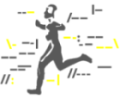





Search | Sitemap | Navigation |  |
|
||||||||||||||||||||||||||
|
||||||||||||||||||||||||||
|
||||||||||||||||||||||||||
|
| Chris Lock |
Isidore Grossman

Isidore Grossman, Migraine, patinated bronze (10" x 8"), 1993. © 2004 Isidore Grossman (lost webpage www.mondomodern.com/p2/fineart/fineartp2a.htm, September 4, 2002)
"I am writing on behalf of my father, Isidore Grossman. He has asked me to respond because his eyesight is not as good as it used to be... He is not, oddly enough, a sufferer of migraines or headaches, however. He said he used to have common headaches when he was younger, but they were not severe and they were alleviated with aspirin quite easily. It has not really been a part of his life, and almost certainly not the inspiration for this piece. His long time friend suffered from them, however... As far as a statement, he likes to not comment on his pieces. He feels the piece, along with it's title, speaks for itself."
(Gideon Grossman, Email to Klaus Podoll, September 25, 2002)
Artist's Profile"New York sculptor Isidore Grossman ... exhibited rarely but prominently in his long and interesting career: a stone bust entitled 'Negro Boy' appeared in the 1939 World's Fair, and his sculptures were exhibited at the Whitney Museum in 1953. Today, Grossman continues to reach new audiences with his work. Born in 1908 to Austrian immigrants, Isidore Grossman grew up on the Lower East Side and Coney Island. Grossman first learned to sculpt on a trip to Florida when he was 18, using clay from dirt roads to make his first works. Back in New York, Grossman began studying at the Art Students League on 57th Street. Shortly thereafter, Grossman began working seriously as a sculptor out of a storefront in the East Village. Grossman's work, begun during the Depression and continuing through World War II, employs humor to evoke compassion and tolerance but mostly, to tell a good story. One of his later works, from around 1980, is a bronze of two penises, one in a groom's suit with tails and the other shorter penis in a bridal gown. The piece is called 'You May Kiss the Bride.' A bronze bust of a clown with a finger pointing straight out of one eye socket reveals anger within the symbol of happiness. The senses are omnipresent in Grossman's work: a telephone receiver with a tongue licking its way out of the talking end, a black bust called 'Migraine' splits the head and the eyes, the sight, in a Cubist style, cutting off light and thought and vision. A bronzed light bulb encasing a pair of deep-set black eyes is called 'Blindman'. During the Depression, Grossman worked for the Works Progress Administration. Here Grossman experimented with stone (marble) alongside WPA artists such as Nathaniel Caz. At the end of the WPA, the staff at the loft on King Street in the West Village threw out hundreds of paintings and sculptures created during the WPA program. Sadly, none of Grossman's work from that time remains. Before and after World War II, Grossman apprenticed with Jacques Lipchitz. (During the war he was an enlisted officer, despite being well into his 30's.) His respect for the great French sculptor has not faded. He calls Lipchitz 'the master' and the two were also good friends, attending boxing events at Madison Square Garden and lunching regularly together. Grossman is briefly mentioned in Lipchitz's autobiography 'My Life in Sculpture'. Around this same time, he and sculptor Isamu Noguchi turned some garages on West 51st Street into studios and Grossman became friendly with Noguchi, often taking him around New York Harbour on his boat. In 1960 Grossman took a studio on West 22nd Street where he worked with his wife Betty, also an artist, for 40 years. Isidore Grossman's is currently for sale at Mondo Cane at 142 West 22nd Street." (Artist's Profile provided by Greg Wooten, Mondo Cane, New York, www.mondomodern.com, September 10, 2002) |
References
Lipchitz J, Arnason HH. My Life in Sculpture. Thames and Hudson, London 1972.
Author: Klaus Podoll
Last modification of this page: Mon. Dec. 20. 2004
| Chris Lock |
 Top of the page
Top of the page| · | News |
| · | Medical Professionals |
| · | Medical Studies |
Copyright © 2005 Migraine Aura Foundation, All rights reserved. Last modification of this site: August 25, 2006
Thanks to: RAFFELT MEDIENDESIGN and GNU software | webmaster@migraine-aura.org
http://migraine-aura.org/EN/Isidore_Grossman.html


